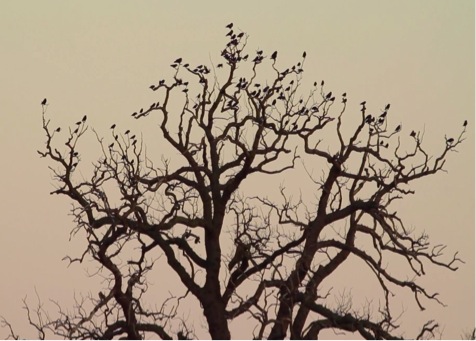[10] Le Ballet des Freux

The cawing rooks whirl round the frosted stack,
Or crowd the dripping boughs....
—Oscar Wilde2
1
There are at least two possible theories of the origins of dance. In the first, dancing is natural, arising from the spontaneous expression of emotion. Here, the movements of arms and legs are like the furrowing of a brow, or the mouth twisted in agony. According to the second account, dancing is artificial, movements deliberately designed and eventually becoming part of an idiom or code, like the flag positions in classic semaphore. A third thing about dance is, however, that the most spontaneous and emotional routines can be learned and performed by another. When dancers today dance one of Isadora Duncan’s wild prances in the surf, do they have to feel the same emotions as she did...is that even possible?
each rook rising
calls upon unconscious skills
not imagining
diving like a hurled stone
could turn itself into flight
as if the patterns
of their darts and curlicues
had been sketched before
on the air and they just went
where the lines told them to go
thrown handfuls of stars
diamonds or just common sand
sparkling in the sun
like a parliament of rooks
lifting as one from the trees
2
A bunch of us were eating lunch upstairs at Nieman-Marcus in San Francisco, and I turned from the conversation and saw out the window a hawk perched on the head of a gargoyle across the street. He was watching several flocks of pigeons as they flew back and forth down the canyon between the tall buildings. He seemed suddenly to just fall from his perch, as if he’d slipped off the gargoyle and fell, but then as he came closer to a passing flock of pigeons he put on the brakes, becoming suddenly an artful flier, and curved into the pigeons, feet and talons first. I saw a little silent explosion of feathers and, as the pigeons scattered in all directions, the hawk flew off with the one dead pigeon in his grip. He flew away over the tall buildings and disappeared.
not art but the real
thing, aerial dive bomber
doing loop-de-loops
as pigeons swim by like the slow
corps de ballet in Black Swan
the rooks really are
dancing, making pirouettes
as they turn to clouds
of black motion, shredding air
on their way back to the sky
I dream now of rooks
whenever I soar the night
skies. Birds on sacred missions
little birds, mouths wide open
calling into the blackness
3
Libretto
At RISE: A large colony of rooks is returning to its familiar giant oak. The birds settle like black fruit on the still leafless branches. Restless, the rooks are eager to begin the task of nestbuilding. We notice that they work in pairs as they first fly away and then come back with sticks and twigs in their beaks. In their pairs, they begin to push the sticks into the forks of high-up limbs, and after a time, a dozen large nests begin to take form. Still the rooks fly away, searching for more sticks and for food, and again they come straight back to the oak and to their mates. A scuffle breaks out in the highest nest; an interloper has tried to interfere with one of the rook couples. The pair drives him off. Birds continue to fly off again and come back. Flying up and settling down, they make a kind of dance up there in the branches, cawing and scuffling, bringing back more sticks, leaping in and out of the growing nests until, as the light dims and night arrives on the stage, the rooks circle slowly, find their places, and settle in. CURTAIN.
the rooks hoard wisdoms
they keep from the rest of us
and hardly notice
we’re the crown of creation
just somewhere in the background
the world is dancing
everywhere the rhythms pulse
a dance of being
alive. Formal movement can’t
keep up, can’t twist quick enough
what a metaphor
for living, the rookery!
across the divide
there is something going on
you sense it, but can’t get in
Bio: Charles D. Tarlton
